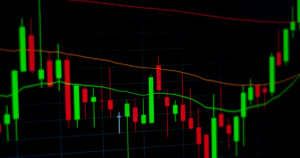The carry trade is a popular investment strategy that allows investors to profit from the differences in interest rates between two currencies. This strategy involves borrowing from a currency with a low-interest rate and using the funds to invest in a currency with a higher interest rate. By taking advantage of interest rate differentials, investors can generate returns based on the interest rate spread. However, it is important to note that carry trade comes with its own set of risks and considerations.
Key Takeaways:
- The carry trade strategy involves borrowing from a low-interest-rate currency and investing in a high-interest-rate currency.
- Investors can profit from the interest rate differentials between currencies.
- The carry trade can be both profitable and risky, depending on market conditions and risk management strategies.
- The yen carry trade is a popular example of this strategy, where traders borrow yen at low-interest rates to invest in higher-yielding assets in other currencies.
- Leveraging trades can amplify both gains and losses, emphasizing the importance of managing risks effectively.
Basics of Carry Trade Strategy
To employ the carry trade strategy, investors borrow funds from a currency with a low-interest rate and invest in a currency with a higher interest rate. This strategy aims to capitalize on the interest rate differentials between two currencies. By borrowing at a low rate and investing in a higher-yielding asset, investors can potentially generate returns through the interest rate differential.
Currency exchange strategies play a crucial role in the carry trade. Traders carefully assess the interest rate spreads between currencies and select pairs that offer the most favorable differentials. The primary objective is to maximize the potential for interest income while minimizing the risk of exchange rate fluctuations.
Risk management in forex is paramount when implementing the carry trade strategy. While the potential for profit exists, it is essential to recognize the inherent risks involved. Exchange rates are subject to volatility, which can lead to losses if not managed effectively. Traders must establish stop loss orders to limit potential downside and implement risk management techniques such as diversification and position sizing to mitigate risk.
| Benefits of Carry Trade Strategy | Risks of Carry Trade Strategy |
|---|---|
|
|
Example of Carry Trade: Yen Carry Trade
The yen carry trade serves as a notable example of the carry trade strategy. The Japanese yen is often borrowed at low-interest rates, and the funds are invested in higher-yielding assets denominated in other currencies. This strategy can potentially magnify returns due to the interest rate differential and leverage.
“The carry trade can be profitable when interest rates are increasing or expected to increase, but it can be detrimental when interest rates decrease. Therefore, it is crucial for traders to closely monitor interest rate announcements and economic indicators.”
Leveraging trades can amplify both gains and losses. While leverage enhances potential profits, it also heightens the risks, making effective risk management crucial. Traders must regularly monitor market conditions, maintain a disciplined approach, and adjust their positions accordingly to minimize losses and protect capital.
Carry trading, with its potential for high profits, attracts experienced investors, but it should be approached with caution by inexperienced traders. The complexity of the forex market and the intricate dynamics of interest rate differentials require a thorough understanding and careful risk management.
| Advantages of Carry Trade | Disadvantages of Carry Trade |
|---|---|
|
|
Impact of Carry Trade on Global Economies
Carry trade activities have significant implications for global economies and financial markets. The strategy involves capital flows between different currencies and countries, affecting exchange rates and interest rates. It can have an impact on currency valuations, trade balances, and monetary policies of nations.
While the carry trade strategy can offer potential opportunities for investors, it is important to remain cautious and mindful of the risks involved. Implementing effective risk management techniques and staying well-informed about market conditions are essential for success in carry trading.
Benefits of Carry Trade
Carry trade offers investors the opportunity to generate significant returns by capitalizing on interest rate differentials in various currency pairs. By borrowing in a low-interest-rate currency and investing in a high-interest-rate currency, investors can potentially earn the difference in interest rates as profit.
One of the key benefits of carry trade is the potential for earning passive income through interest rate differentials. This strategy is particularly attractive in times of stable or increasing interest rates, as it allows investors to earn consistent profits from the higher-yielding currency. Additionally, carry trade can provide diversification benefits to a portfolio, as it involves investing in multiple currency pairs, thus spreading out the risk.
Carry trade is also favored by many investors for its potential to provide returns in both rising and falling markets. While rising interest rates can increase the profitability of this strategy, even in a low-interest-rate environment, carry trade can still generate positive returns. This is because the gains from the higher-yielding currency can offset the lower borrowing costs.
| Advantages of Carry Trade | Disadvantages of Carry Trade |
|---|---|
|
|
“Carry trade offers the potential for high profits, but it also carries risks, especially for inexperienced traders. It is important to have a solid understanding of risk management strategies and to carefully monitor market conditions.”
Overall, carry trade can be a lucrative strategy for experienced investors who are willing to manage the associated risks. By carefully assessing interest rate differentials, implementing effective risk management techniques, and staying informed about global economic developments, investors can potentially benefit from the carry trade strategy in the dynamic global financial markets.
Risks of Carry Trade
While carry trade can be profitable, it is important to be aware of the risks involved, such as exchange rate fluctuations and sudden shifts in interest rates. These risks can have a significant impact on the profitability of carry trade strategies in the forex market. In order to effectively manage these risks, traders need to adopt suitable forex trading strategies and risk management techniques.
One of the primary risks of carry trade is exchange rate fluctuations. Currencies are constantly influenced by various economic and political factors, which can lead to sudden and unpredictable changes in their values. These fluctuations can either significantly increase returns or result in losses for carry trade positions. Traders need to closely monitor and analyze market trends in order to make informed decisions and mitigate the risks associated with these fluctuations.
| Risks of Carry Trade | Impact |
|---|---|
| Exchange rate fluctuations | Potential for significant gains or losses |
| Sudden shifts in interest rates | Affects profitability of carry trade positions |
| Market liquidity | Potential difficulty in exiting positions |
Another risk to consider is sudden shifts in interest rates. Interest rates play a crucial role in carry trade strategies, as they determine the profitability of borrowing in one currency and investing in another. Central banks have the authority to change interest rates based on their monetary policy objectives, and unexpected rate changes can significantly impact carry trade positions. Traders must closely follow central bank announcements and economic indicators to anticipate potential interest rate shifts and adjust their strategies accordingly.
Market liquidity is also an important risk to be aware of in carry trade. If markets become highly crowded or volatile, it may be challenging to exit carry trade positions at desired levels. Traders may face difficulties in finding suitable counterparties to unwind their positions, which can lead to potential losses if forced to exit at less favorable rates. It is crucial for traders to ensure that there is sufficient market liquidity and have contingency plans in place to manage such situations.
Summary:
- Exchange rate fluctuations and sudden shifts in interest rates are significant risks in carry trade strategies.
- Monitoring and analyzing market trends is essential to mitigate the risks associated with exchange rate fluctuations.
- Keeping track of central bank announcements and economic indicators helps anticipate potential interest rate shifts.
- Maintaining sufficient market liquidity and having contingency plans in place is crucial for managing risks in carry trade.
It is important for traders to carefully consider the risks involved in carry trade and implement effective risk management strategies in order to maximize potential profits and minimize losses.
The Yen Carry Trade Example
The yen carry trade is a popular example of the carry trade strategy, where traders borrow yen at low-interest rates and invest in higher-yielding assets in other currencies. This strategy takes advantage of the interest rate differential between the Japanese yen and other currencies, offering the potential for substantial profits.
When engaging in the yen carry trade, traders typically borrow yen at low-interest rates and then convert it into a currency with a higher interest rate, such as the US dollar or the euro. The borrowed yen is then used to invest in assets denominated in the chosen currency, such as government bonds or stocks.
The key to the success of the yen carry trade lies in the interest rate differential. If the interest rates in the borrowed currency remain stable or increase, traders can earn a significant return on their investment. However, if the interest rates in the borrowed currency decrease, the profitability of the carry trade can diminish or even turn negative. Therefore, managing risk and closely monitoring interest rate movements is crucial for carry traders to avoid potential losses.
The Risks of the Yen Carry Trade
While the yen carry trade can be highly profitable, it is important to be aware of the risks involved. One of the main risks is currency volatility. Exchange rate fluctuations can erode profits or even result in losses for carry traders, especially if the borrowed currency strengthens against the yen. Additionally, leverage amplifies both gains and losses, making risk management critical to protect capital.
In conclusion, the yen carry trade is a strategy that allows traders to profit from the interest rate differentials between currencies. While it can be lucrative, it comes with risks that should not be overlooked. Successful carry traders must carefully monitor interest rate movements, manage risk effectively, and stay informed about global economic trends that could impact currency markets. By doing so, they can potentially generate significant returns from the yen carry trade.
Managing Risks in Carry Trading
Managing risks is crucial in carry trading, given the potential for high leverage and volatility in the currency markets. The carry trade strategy, which involves borrowing funds from a currency with a low-interest rate and investing in a currency with a higher interest rate, can generate significant profits. However, it also exposes traders to various risks that need to be carefully managed to protect investments.
One of the key risks in carry trading is exchange rate volatility. Currency prices can fluctuate rapidly, leading to potential losses if not properly anticipated and managed. Traders should closely monitor market conditions, economic indicators, and geopolitical events that can impact currency values. Implementing stop-loss orders and setting realistic profit targets can help mitigate the risk of significant losses.
Another risk to consider is interest rate differentials. While carry traders aim to profit from the interest rate spread between currencies, changes in interest rates can impact the profitability of trades. It is important to stay informed about central bank policies and monetary decisions that can affect interest rates. Diversifying across different currencies and regions can also help reduce the impact of interest rate fluctuations.
Table 1: Risk Management Strategies in Carry Trading
| Risk | Management Strategy |
|---|---|
| Exchange rate volatility | – Monitor market conditions and economic indicators |
| – Set stop-loss orders and profit targets | |
| Interest rate differentials | – Stay informed about central bank policies and monetary decisions |
| – Diversify across different currencies and regions |
Leverage is another aspect that needs careful consideration. While leverage can amplify profits in carry trading, it also amplifies losses. Traders should only use leverage that they can afford to lose and set strict risk management rules to avoid excessive losses. It is advisable to start with lower leverage ratios and gradually increase them as experience and confidence grow.
In conclusion, managing risks in carry trading is essential for preserving capital and achieving consistent profits. Traders should be aware of the potential risks associated with exchange rate volatility, interest rate differentials, and leverage. By implementing appropriate risk management strategies and staying informed about market conditions, traders can increase their chances of success in the forex market.
Advantages and Disadvantages of Carry Trade
Carry trade can be advantageous in stable markets, providing the potential for high profits, but it is important to be aware of the associated risks, particularly for inexperienced traders. One of the main advantages of carry trade is the opportunity to capitalize on interest rate differentials between currencies. By borrowing in a currency with a low interest rate and investing in a currency with a higher interest rate, traders can earn a positive interest rate differential or “carry” on their positions. This can result in substantial returns, especially when the interest rate spread is wide and remains stable.
Another advantage of carry trade is its potential for generating passive income. Unlike many other trading strategies that require active monitoring and frequent decision-making, carry trade positions can be held over longer periods, allowing traders to earn interest on their investments without continuous involvement. This makes it an attractive option for investors seeking a more hands-off approach to forex trading.
However, it is crucial to recognize that carry trade also comes with its fair share of risks. One of the primary risks is the potential for capital losses if the exchange rates move against the trader’s positions. Since carry trade involves borrowing in one currency and investing in another, fluctuations in exchange rates can significantly impact the profitability of the strategy. Additionally, carry trade can become less attractive during periods of global economic volatility or increased market uncertainty, as sudden shifts in market sentiment can lead to significant currency fluctuations.
In conclusion, carry trade can offer significant advantages in stable markets, providing the potential for high profits and passive income. However, it is essential to carefully assess and manage the associated risks, especially for inexperienced traders. By staying informed, adopting effective risk management strategies, and being mindful of market conditions, investors can navigate the complexities of carry trade and potentially benefit from this forex trading strategy.
Impact of Carry Trade on Global Economies
Carry trade has a significant impact on global economies and financial markets, as it involves the movement of capital between different currencies and countries. This strategy, which capitalizes on interest rate differentials, influences exchange rates and can play a role in shaping economic conditions.
One of the major impacts of carry trade is the flow of capital from low-interest-rate countries to high-interest-rate countries. Investors seek out currencies with higher yields and borrow in low-yielding currencies to finance their investments. This movement of capital can lead to fluctuations in exchange rates, as demand for higher-yielding currencies increases, potentially affecting trade balances and overall economic stability.
Furthermore, the carry trade strategy can induce changes in interest rates. When funds from carry trades flow into a country, it can lead to increased demand for that currency, resulting in upward pressure on its value. In response, central banks may raise interest rates to prevent the currency from appreciating too rapidly. Conversely, if carry trades unwind, with investors selling their investment currencies and buying back the funding currencies, it can lead to a depreciation of the higher-yielding currencies and potentially impact interest rate decisions.
The impact of carry trade on global economies extends beyond exchange rates and interest rates. It can also affect financial markets, as the influx or outflow of capital can lead to increased volatility and influence asset prices. Moreover, large carry trades can create crowded markets, as many investors participate in the same strategy. This can increase the risk of market disruptions if a sudden reversal or unwinding of carry trades occurs.
Overall, the carry trade strategy has both advantages and risks, and its impact on global economies and financial markets cannot be ignored. While it presents opportunities for investors to generate returns from interest rate differentials, it also carries the potential for market instability and economic imbalances. Therefore, it is crucial for investors to carefully assess and manage the risks associated with carry trading, especially in a constantly evolving global financial landscape.
| Carry Trade | Impact on Global Economies |
|---|---|
| Involves borrowing from low-interest-rate currencies and investing in high-interest-rate currencies | This can lead to fluctuations in exchange rates and impact trade balances |
| Affects interest rates in countries as capital flows in or out | Can increase volatility in financial markets and influence asset prices |
| Presents both opportunities and risks for investors | Requires careful risk assessment and management |
Conclusion
In conclusion, carry trade can be a profitable forex trading strategy for investors who carefully manage the associated risks and leverage its potential for high profits. Understanding the carry trade is important for investors who are interested in generating returns from the differences in interest rates between two currencies. The carry trade strategy involves borrowing from a currency with a low interest rate and using the funds to invest in a currency with a higher interest rate.
This strategy has been popular among individual investors and traders, but it can be risky due to high leverage and crowded markets. The carry trade can be profitable when interest rates are increasing or expected to increase, but it can be detrimental when interest rates decrease. The yen carry trade is a popular example of this strategy, where traders borrow yen at low interest rates and invest in higher-yielding assets in other currencies.
Leveraging trades can amplify both the gains and losses, so it is important to manage risks carefully. Carry trading can be advantageous in stable markets, as it provides the potential for high profits, but it also carries risks, especially for inexperienced traders. This strategy has an impact on global economies and markets, as it involves capital flows between different currencies and countries.
FAQ
Q: What is the carry trade?
A: The carry trade is a strategy where investors borrow in a currency with low-interest rates and use the funds to invest in a currency with higher interest rates, aiming to profit from the interest rate differentials.
Q: Why is understanding the carry trade important for investors?
A: Understanding the carry trade is important for investors as it provides an opportunity to generate returns from interest rate differences between currencies and can significantly impact investment strategies in the foreign exchange market.
Q: What are the risks of carry trade?
A: The carry trade can be risky due to high leverage and crowded markets. It can result in losses when interest rates decrease or unexpected currency movements occur, making risk management crucial for traders.
Q: How does the yen carry trade work?
A: The yen carry trade is a popular example of the carry trade strategy. Traders borrow yen at low-interest rates and invest in higher-yielding assets in other currencies, taking advantage of the interest rate differentials.
Q: How can risks in carry trading be managed?
A: Risks in carry trading can be managed through effective risk management strategies, including setting proper stop-loss orders, diversifying investments, and closely monitoring market trends and economic indicators.
Q: What are the advantages and disadvantages of carry trade?
A: Carry trade offers the potential for high profits in stable markets and provides opportunities for currency investing. However, it also carries risks, especially for inexperienced traders, and can result in losses during market downturns or unexpected currency movements.
Q: How does carry trade impact global economies?
A: Carry trade involves capital flows between different currencies and countries, which can have a significant impact on global economies and financial markets. It influences exchange rates, interest rates, and overall market stability.








